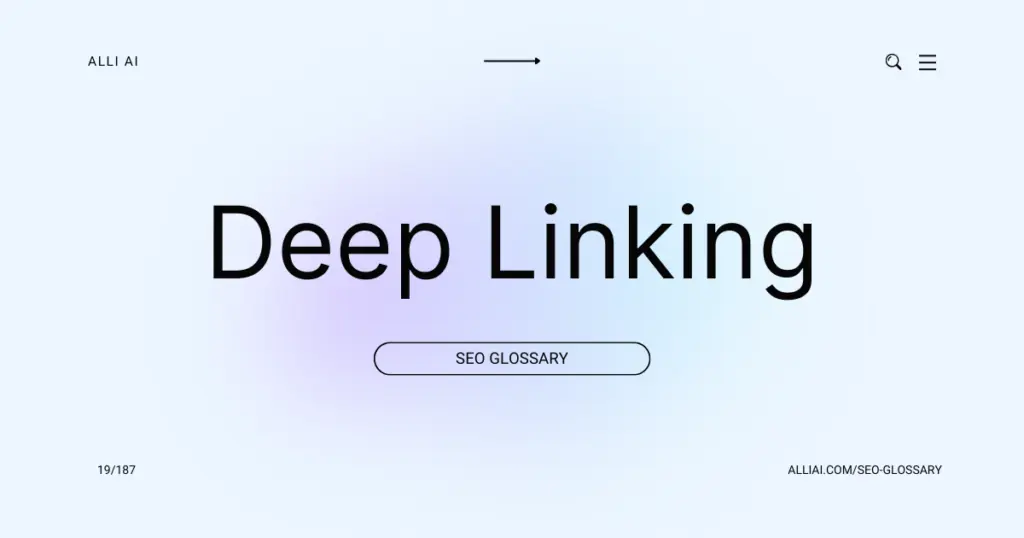What Does Deep Linking Mean?
Deep linking refers to the practice of creating hyperlinks that point to a specific, generally searchable or indexed, piece of web content rather than the website’s homepage. These links lead directly to a page or position within the application, such as a product detail page in an e-commerce app or a specific content page on a website, bypassing the home page or other introductory pages. This is useful for directing users exactly where they need to go without additional navigation.
Where Does Deep Linking Fit Into The Broader SEO Landscape?
Deep linking directly impacts user engagement and satisfaction by providing a seamless user experience. It enhances the relevance of search results by guiding users precisely to the information they are searching for, rather than making them navigate from a generic homepage. By improving user experience and engagement, websites are likely to see a reduction in bounce rates and an increase in time spent on the site, both of which are positive signals to search engines about the site’s value, potentially improving rankings.
Furthermore, deep linking increases the indexable surface area of a website. When deep links are indexed by search engines, it allows for a broader section of the site’s content to be displayed directly in search engine results. This can increase the number of entry points a website has in search results, improving its visibility and traffic.
Deep linking can also enhance link equity distribution across a website. By linking directly to internal pages rather than just to a homepage or top-level pages, deep links help spread page authority and ranking power throughout the site more evenly, which can assist less prominent pages in ranking better for specific queries.
In the mobile context, deep linking can refer to the practice of linking to specific content within a mobile application, which can be indexed by Google through app indexing. This practice makes it possible for content within apps to appear in search engine results, thereby driving additional traffic to the app and improving user retention and engagement within the app ecosystem. This is particularly relevant as the use of mobile devices continues to grow and users increasingly turn to apps for specific needs.
Real Life Analogies or Metaphors to Explain Deep Linking
Deep linking is like giving someone a key to a specific room in a large mansion, rather than making them enter through the main gate and search for the room themselves.
How the Deep Linking Functions or is Implemented?
1. Identify the Target Content: Choose the specific content within the app or the website that you want to link.
2. Create a Deep Link URL: This involves structuring a URL that directs straight to the internal page or piece of content. For websites, this is straightforward HTTP links. For mobile apps, you can create custom URL schemes (like myapp://page) or use Universal Links (iOS) and App Links (Android).
3. URL Handling:
– For Websites: Ensure that the URL points directly to the necessary content page.
– For Mobile Apps:
– Custom URL Schemes: Configure your app to register a custom scheme so the app can open directly from the URL.
– Universal Links and App Links: Implement these to allow links to open your app if installed, falling back to a webpage if not.
4. Update App and Website Configuration:
– Mobile Apps: Update your app manifest (Android) or your info.plist (iOS) to define supported URL formats and associate your app with certain domains.
– Websites: Add support for handling incoming app links. For Universal Links, add the `apple-app-site-association` file. For App Links, add the `assetlinks.json` file.
5. Testing and Validation: Use tools and testing frameworks to validate that the deep links open the correct pages both on websites and in mobile applications.
6. Distribution:
– Embed these deep links in emails, SMS, social media, or other marketing materials.
– Utilize these links within the mobile app or website for navigation.
7. Monitoring and Analytics: Track the performance and usage of deep links through analytics to understand engagement and optimize accordingly.
Impact Deep Linking has on SEO
Deep linking enhances a website’s SEO performance by improving user engagement and site navigation, which are key factors in Google’s ranking algorithm. It links directly to pages deeper within the site structure rather than just the homepage, distributing page authority and link juice throughout the site more effectively. This can lead to increased visibility and higher rankings for individual pages on search engine results pages (SERPs).
It also significantly improves user experience by reducing the number of clicks required to reach relevant content, directly influencing metrics such as bounce rate and time on site. By allowing users to land precisely on the most relevant page, deep linking can increase the likelihood of conversions, further signaling to search engines that the content is valuable and well-structured.
Moreover, deep linking enables search engines to index deeper pages more effectively, increasing the breadth of content available in search results, which is beneficial for capturing a wider array of long-tail search queries. It also helps in the contextual relevancy of pages through accurate and descriptive anchor texts, strengthening the semantic relationship between linked pages.
SEO Best Practices For Deep Linking
1. Ensure that your website’s structure is hierarchical and logical, making it easier for both users and search engines to navigate.
2. Update your site’s XML sitemap regularly, including all deep links to ensure search engines can crawl and index them.
3. Use descriptive, keyword-rich URLs for each webpage, which helps search engines find your pages and understand their content for relevancy.
4. Implement breadcrumb navigation on your website to help users understand their location within the site hierarchy and to improve the internal linking structure.
5. Optimize on-page elements such as title tags, meta descriptions, headers, and content with relevant keywords for the specific deep pages.
6. Enhance internal linking by linking to deep pages from other relevant content within your site, which can spread link equity and improve rankings.
7. Use structured data markup (like schema.org) to help search engines understand the context of the page content and index it appropriately.
8. Build backlinks directly to deep links from high-quality external sites which enhance the page’s authority and visibility.
9. Monitor and minimize site loading times specifically for deep-linked pages, ensuring a good user experience and supporting higher rankings.
10. Regularly check and fix any broken links or errors (like 404s) that could disrupt indexing and user experience related to deep links.
11. Leverage social media platforms to share deep links directly, increasing direct traffic and social signals for these pages.
12. Implement canonical tags on deep links if there are similar pages with duplicate content to avoid negative SEO impacts such as keyword cannibalization.
13. Regularly track the performance of deep-linked pages using analytics tools to understand user behavior and optimize accordingly.
14. Keep your website content updated and fresh, adding new information to deep-linked pages, which can boost their relevancy and visibility.
Common Mistakes To Avoid
1. Ignoring Platform-Specific Guidelines: Each operating system, like iOS and Android, has specific protocols for deep linking. Not adhering to the rules can lead to non-functioning links. Ensure compatibility by following the latest guidelines provided by each platform.
2. Lack of URI Scheme Consistency: Inconsistent URI structuring can confuse users and engines, and even prevent the link from working. Maintain a clear, hierarchically logical URI scheme across your application.
3. Skipping Redirect Validation: When implementing deep linking, it’s critical to validate all redirects to protect users from potential security threats. Unauthorized redirects can expose users to harmful sites.
4. Poor User Experience for First-Time Installers: Deep links can fail for users who don’t have the app installed. Use deferred deep linking which operates even after the app has been downloaded and installed.
5. Forgetting Cross-Platform Functionality: A link that works on one device may not work on another if not properly configured. Test deep links across multiple platforms and devices to ensure functionality.
6. Overlooking Link Maintenance: Deep links can break with updates to your app or website. Regularly test and update deep links to ensure they continue to function correctly.
7. Not Using Fallback Measures: Failing to provide alternative actions when a link can’t resolve can frustrate users. Implement fallback options such as directing to a web page or suggesting the user download the app.
8. Neglecting Analytics: Not tracking the performance and usage of deep links can lead to missed opportunities for optimization and improvement. Employ tools that monitor and analyze link usage.
9. Inconsistent Testing Across Devices and OS Versions: Sometimes, deep links are only tested on the latest devices and OS versions, missing potential issues on older systems still in use. Test across a spectrum of devices and OS variants.
10. Using Only One Type of Deep Linking: Relying solely on traditional deep linking and ignoring Universal or App Links can limit reach and functionality. Utilize different types of deep linking depending on user needs and device capabilities.






